Measurement of muon- antineutrino and neutrino charged-current inclusive cross sections and their ratio with the T2K off-axis near detector
We report a measurement of cross section σ(νμ+nucleus→μ-+X) and the first measurements of the cross section σ(ν¯μ+nucleus→μ++X) and their ratio R(σ(ν¯)σ(ν)) at (anti) neutrino energies below 1.5 GeV. We determine the single momentum bin cross section measurements, averaged over the T2K ν¯/ν-flux, for the detector target material (mainly carbon, oxygen, hydrogen and copper) with phase space restricted laboratory frame kinematics of θμ<32° and pμ>500 MeV/c. The results are σ(ν¯)=(0.900±0.029(stat)±0.088(syst))×10-39 and σ(ν)=(2.41±0.022(stat)±0.231(syst))×10-39 in units of cm2/nucleon and R(σ(ν¯)σ(ν))=0.373±0.012(stat)±0.015(syst).
Measurement of inclusive double-differential νμ charged-current cross section with improved acceptance
We report a measurement of the flux-integrated cross section for inclusive muon neutrino charged-current interactions on carbon. The double differential measurements are given as function of the muon momentum and angle. Relative to our previous publication on this topic, these results have an increased angular acceptance and higher statistics. The data sample presented here is 5.7 × 10^20 protons-on-target. The total flux-integrated cross section is measured to be (6.950 ± 0.662) × 10^−39 cm^2/nucleon and is consistent with our simulation.
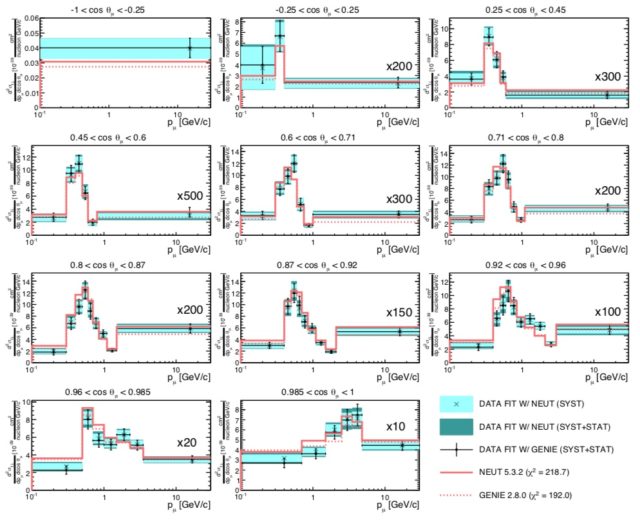
Characterisation of nuclear effects in neutrino scattering with a measurement of final-state kinematics (2018)
This paper reports measurements of final-state proton multiplicity, muon and proton kinematics, and their correlations in charged-current pionless neutrino interactions, measured by the T2K ND280 near detector in its plastic scintillator (C8H8) target. The data were taken between years 2010 and 2013, corresponding to approximately 6×10^20 protons on target. Thanks to their exploration of the proton kinematics and of kinematic imbalances between the proton and muon kinematics, the results offer a novel probe of the nuclear-medium effects most pertinent to the (sub-)GeV neutrino-nucleus interactions that are used in accelerator-based long-baseline neutrino oscillation measurements. These results are compared to many neutrino-nucleus interaction models which all fail to describe at least part of the observed phase space. In case of events without a proton above a detection threshold in the final state, a fully consistent implementation of the local Fermi gas model with multinucleon interactions gives the best description of the data. In the case of at least one proton in the final state the spectral function model agrees well with the data, most notably when measuring the kinematic imbalance between the muon and the proton in the plane transverse to the incoming neutrino. A clear indication of existence of multinucleon interactions is observed. The effect of final-state interactions is also discussed.
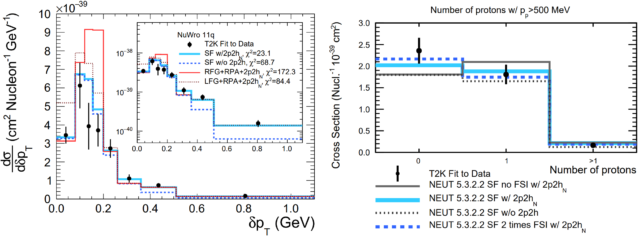
First measurement of the νμ charged-current cross section without pions in the final state on a water target
We report the first differential measurement of the charged-current interaction cross section of νμ on water with no pions in the final state. This flux-averaged measurement has been made using the T2K experiment’s off-axis near detector, and is reported in doubly-differential bins of muon momentum and angle. The flux-averaged total cross section in a restricted region of phase space was found to be σ=(0.95±0.13)×10−38cm2 per n.
arXiv:1708.06771 [hep-ex], Phys.Rev. D97 (2018) no.1, 012001. The data release for this paper is here.
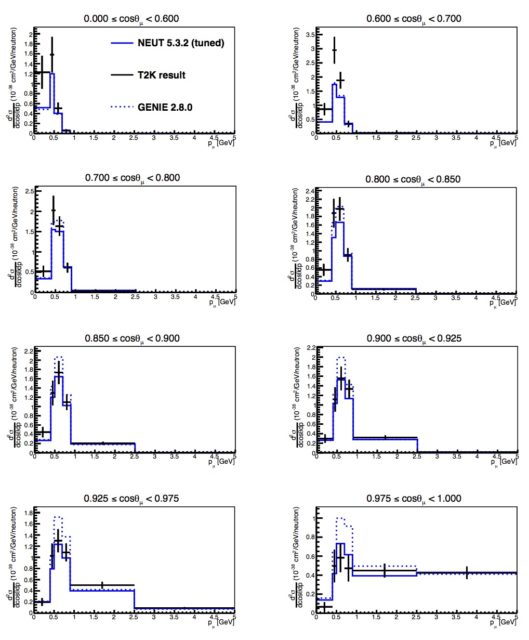
Measurement of Coherent π+ Production in Low Energy Neutrino-Carbon Scattering
We report the first measurement of the flux-averaged cross section for charged current coherent π+ production on carbon for neutrino energies less than 1.5 GeV, and with a restriction on the final state phase space volume in the T2K near detector, ND280. Comparisons are made with predictions from the Rein-Sehgal coherent production model and the model by Alvarez-Ruso et al., the latter representing the first implementation of an instance of the new class of microscopic coherent models in a neutrino interaction Monte Carlo event generator. We observe a clear event excess above background, disagreeing with the null results reported by K2K and SciBooNE in a similar neutrino energy region. The measured flux-averaged cross sections are below those predicted by both the Rein-Sehgal and Alvarez-Ruso et al. models.
First Measurement of the Muon Neutrino Charged Current Single Pion Production Cross Section on Water with the T2K Near Detector
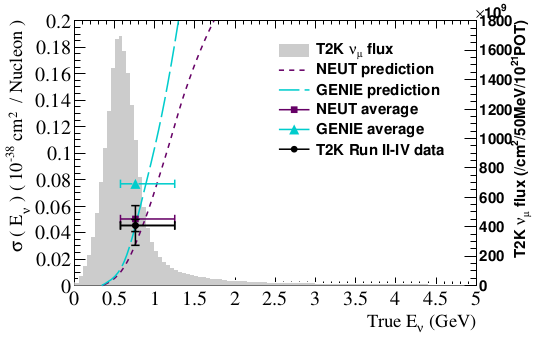
The T2K off-axis near detector, ND280, is used to make the first differential cross section measurements of muon neutrino charged current single positive pion production on a water target at energies ∼0.8~GeV. The differential measurements are presented as a function of muon and pion kinematics, in the restricted phase-space defined by pπ+>200MeV/c, pμ− >200MeV/c, cosθπ+ >0.3 and cosθμ− >0.3. The total flux integrated νμ charged current single positive pion production cross section on water in the restricted phase-space is measured to be ⟨σ⟩ϕ=4.25±0.48 (stat)±1.56 (syst)×10−40 cm2/nucleon. The total cross section is consistent with the NEUT prediction (5.03×10−40 cm2/nucleon) and 2σ lower than the GENIE prediction (7.68×10−40 cm2/nucleon). The differential cross sections are in good agreement with the NEUT generator. The GENIE simulation reproduces well the shapes of the distributions, but over-estimates the overall cross section normalization.
Measurement of double-differential muon neutrino charged-current interactions on C8H8 without pions in the final state using the T2K off-axis beam
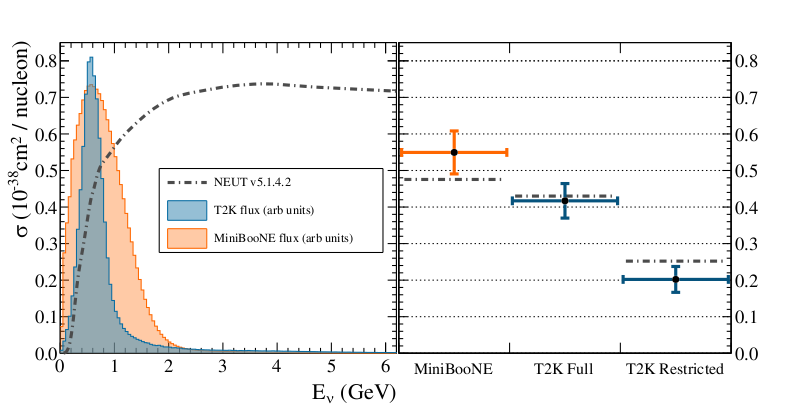
We report the measurement of muon neutrino charged-current interactions on carbon without pions in the final state at the T2K beam energy using 5.734×1020 protons on target. For the first time the measurement is reported as a flux-integrated, double-differential cross-section in muon kinematic variables (cosθμ, pμ), without correcting for events where a pion is produced and then absorbed by final state interactions. Two analyses are performed with different selections, background evaluations and cross-section extraction methods to demonstrate the robustness of the results against biases due to model-dependent assumptions. The measurements compare favorably with recent models which include nucleon-nucleon correlations but, given the present precision, the measurement does not solve the degeneracy between different models. The data also agree with Monte Carlo simulations which use effective parameters that are tuned to external data to describe the nuclear effects. The total cross-section in the full phase space is σ=(0.417±0.047(syst)±0.005(stat))×10−38cm2 nucleon−1 and the cross-section integrated in the region of phase space with largest efficiency and best signal-over-background ratio (cosθμ>0.6 and pμ>200 MeV) is σ=(0.202±0.0359(syst)±0.0026(stat))×10−38cm2 nucleon−1.
Measurement of the muon neutrino inclusive charged-current cross section in the energy range of 1-3 GeV with the T2K INGRID detector
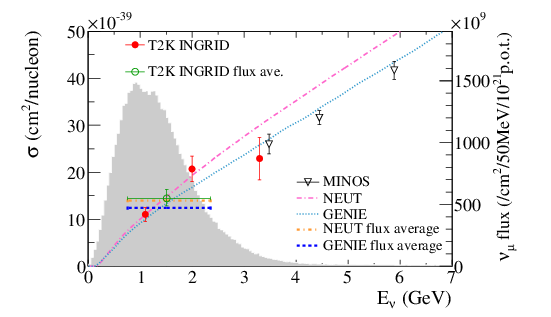
We report a measurement of the νμ-nucleus inclusive charged current cross section (=σcc) on iron using data from exposed to the J-PARC neutrino beam. The detector consists of 14 modules in total, which are spread over a range of off-axis angles from 0° to 1.1°. The variation in the neutrino energy spectrum as a function of the off-axis angle, combined with event topology information, is used to calculate this cross section as a function of neutrino energy. The cross section is measured to be σcc(1.1 GeV)=1.10±0.15 (10−38cm2/nucleon), σcc(2.0 GeV)=2.07±0.27 (10−38cm2/nucleon), and σcc(3.3 GeV)=2.29±0.45 (10−38cm2/nucleon), at energies of 1.1, 2.0, and 3.3 GeV, respectively. These results are consistent with the cross section calculated by the neutrino interaction generators currently used by T2K. More importantly, the method described here opens up a new way to determine the energy dependence of neutrino-nucleus cross sections.
Measurement of the νμ charged current quasi-elastic cross-section on carbon with the T2K on-axis neutrino beam
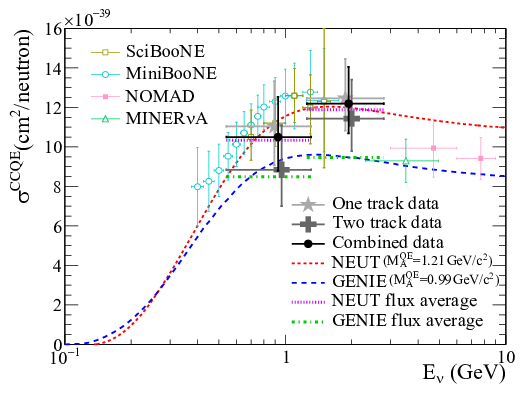
We report a measurement of the νμ charged current quasi-elastic cross-sections on carbon in the T2K on-axis neutrino beam. The measured charged current quasi-elastic cross-sections on carbon at mean neutrino energies of 1.94 GeV and 0.93 GeV are (11.95±0.19(stat.)+1.82−1.47(syst.))×10−39cm2/neutron and (10.64±0.37(stat.)+2.03−1.65(syst.))×10−39cm2/neutron, respectively. These results agree well with the predictions of neutrino interaction models. In addition, we investigated the effects of the nuclear model and the multi-nucleon interaction.
Measurement of the νμ CCQE cross section on carbon with the ND280 detector at T2K
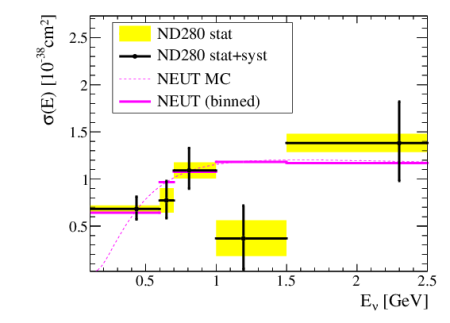
The Charged-Current Quasi-Elastic (CCQE) interaction, νl+n→l−+p, is the dominant CC process at Eν∼1 GeV and contributes to the signal in accelerator-based long-baseline neutrino oscillation experiments operating at intermediate neutrino energies. This paper reports a measurement by the T2K experiment of the νμ CCQE cross section on a carbon target with the off-axis detector based on the observed distribution of muon momentum (pμ) and angle with respect to the incident neutrino beam (θμ). The flux-integrated CCQE cross section was measured to be (0.83±0.12)×10−38 cm2 in good agreement with NEUT MC value of 0.88×10−38 cm2. The energy dependence of the CCQE cross section is also reported. The axial mass, MAQE, of the dipole axial form factor was extracted assuming the Smith-Moniz CCQE model with a relativistic Fermi gas nuclear model. Using the absolute (shape-only) pμcosθμ distribution, the effective MAQE parameter was measured to be 1.26+0.21−0.18 GeV/c2 (1.43+0.28−0.22 GeV/c2).


